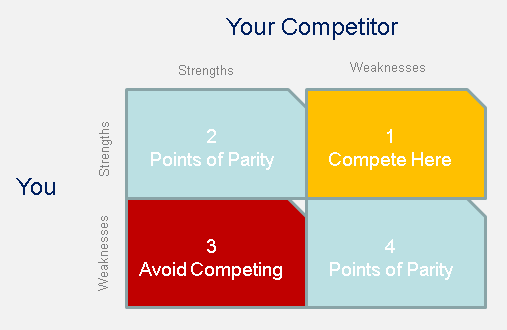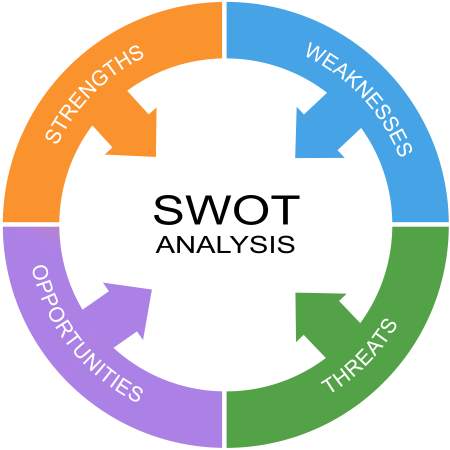Have you ever completed a SWOT analysis on your business, but didn’t really get much value out of it?
You’re not alone. Getting the most out of a SWOT analysis is where many businesses get stuck.
Identifying the internal strengths and weaknesses of your business, along with external opportunities and threats through SWOT analysis is a widely used planning tool. But its true value lies in what you do with it.
Focus on the SW of SWOT
A powerful way to use SWOT is to do a side-by-side SWOT comparison between your business and your main competitor – or competitors – by first focusing on your strengths versus your competitor’s weaknesses. The goal is to clarify your unique competitive advantage. This will serve as a major point of emphasis in conversations with customers to help them choose you over your competition.
As a first step, list your strengths and weaknesses on one SWOT diagram and your competitor’s on another.
Then, consolidate the information into the four quadrants as shown below. This simple framework is extremely useful in helping you pinpoint where you are strong and your competitors are weak.
Validate your assumptions
That said, it’s dangerous to assume your views of your company and your competitors’ strengths and weaknesses are exactly how the customer sees it. The only valid way to check your assumptions is to seek input from your target customers. This can be done through formal research or through informal conversations with them. This is a critical step. Without customer input, you may be basing your decisions on your own biases. Focus conversations on what matters to your customers
Focus conversations on what matters to your customers
It’s important to remember than no company is without its weaknesses. It’s how you position your company to emphasize how your strengths deliver benefits that matter most to your customers, particularly in areas where your competitor has weaknesses. With this in mind, leading conversations with customers using this four quadrant grid can help.
Quadrant 1. Your unique strengths.
The gold area is your company’s power zone. Aim to steer conversations with customers into the gold area. This is where your strengths – in terms of what matters to your customers – are strongest, and your competitor is weakest. When conversations move into other quadrants, deal with them accordingly and circle back here to ensure your customers fully understand the value of your unique strengths.
Quadrant 2. Strengths parity.
In this blue zone, you and a competitor share points of parity on what matter to the customer. In essence you are equals. Here you want to confirm the value to your customer, then position your unique strengths (from the gold area) on top of these points of parity to emphasize what makes you a better choice.
Quadrant 3. Competitor unique strengths.
The red area is a potential danger zone. This is where a competitor has strengths that you don’t. However, these strengths may not be important if they don’t matter to your customer. So find out. It’s important to gain insight into how much these things matter to your customer to help steer your future direction and fuel continuous improvement in your business.
Quadrant 4. Weakness parity.
In the blue weaknesses zone, neither you nor your competitor have strengths. When issues arise here it’s important to learn how much these points matter to your customer. Knowing this can help you prioritise potential areas for continuous improvement and develop additional unique strengths.
Gain strategic advantage
So to get the most out of a SWOT analysis, try doing a side-by-side comparison against your competition. Doing so will clarify your unique competitive advantage for use in conversations with your customers to help them choose you over your competition.
And remember, the best way to find out how your customers view your business and your competition, is by asking them to tell you. Only then will you validate your true competitive advantage. While this sounds simple enough, when was the last time you asked?
https://youtu.be/4iK0P6tb4Qs

